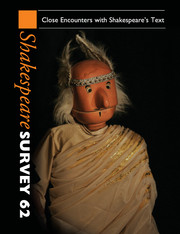Book contents
- Frontmatter
- Shakespeare, text and paratext
- The popularity of Shakespeare in print
- The continuing importance of new Bibliographical method
- ‘Honour the real thing’: Shakespeare, Trauma and Titus Andronicus in South Africa
- ‘O, these encounterers’: on Shakespeare’s meetings and partings
- A play of modals: Grammar and potential action in early Shakespeare
- Merry, marry, Mary: Shakespearian wordplay and Twelfth Night
- A subtle point: Sleeves, tents and ‘Ariachne’s broken woof’ (again)
- The look of Othello
- Red button Shakespeare
- ‘Mark you / his absolute shall?’: Multitudinous tongues and contested words in Coriolanus
- Chagall’s Tempest: An autobiographical reading
- Reading illustrated editions: Methodology and the limits of interpretation
- Close encounters with Anne Brontë's Shakespeare
- Shakespeare and the magic lantern
- Shakespeare and the coconuts: close encounters in post-apartheid South Africa
- The Schrödinger effect: Reading and misreading performance
- Behind the scenes
- Inner monologues: Realist acting and/as Shakespearian performance text
- More japanized, casual and transgender shakespeares
- Translation futures: Shakespearians and the foreign text
- After translation
- ‘The single and peculiar life’: Hamlet’s heart and the early modern subject
- Mapping King Lear
- ‘Last on the stage’: The place of Shakespeare in Charles Darwin’s ethology
- Sense/memory/sense-memory: Reading narratives of Shakespearian rehearsals
- Shakespeare performances in England (and Wales), 2008
- Professional Shakespeare productions in the British Isles, January–December 2007
- The Year's Contributions to Shakespearian Study 1 Critical Studies
- 2 Shakespeare in performance
- 3a Editions and textual studies
- 3b Editions and textual studies
- Index to Volume 62
The look of Othello
Published online by Cambridge University Press: 28 November 2009
- Frontmatter
- Shakespeare, text and paratext
- The popularity of Shakespeare in print
- The continuing importance of new Bibliographical method
- ‘Honour the real thing’: Shakespeare, Trauma and Titus Andronicus in South Africa
- ‘O, these encounterers’: on Shakespeare’s meetings and partings
- A play of modals: Grammar and potential action in early Shakespeare
- Merry, marry, Mary: Shakespearian wordplay and Twelfth Night
- A subtle point: Sleeves, tents and ‘Ariachne’s broken woof’ (again)
- The look of Othello
- Red button Shakespeare
- ‘Mark you / his absolute shall?’: Multitudinous tongues and contested words in Coriolanus
- Chagall’s Tempest: An autobiographical reading
- Reading illustrated editions: Methodology and the limits of interpretation
- Close encounters with Anne Brontë's Shakespeare
- Shakespeare and the magic lantern
- Shakespeare and the coconuts: close encounters in post-apartheid South Africa
- The Schrödinger effect: Reading and misreading performance
- Behind the scenes
- Inner monologues: Realist acting and/as Shakespearian performance text
- More japanized, casual and transgender shakespeares
- Translation futures: Shakespearians and the foreign text
- After translation
- ‘The single and peculiar life’: Hamlet’s heart and the early modern subject
- Mapping King Lear
- ‘Last on the stage’: The place of Shakespeare in Charles Darwin’s ethology
- Sense/memory/sense-memory: Reading narratives of Shakespearian rehearsals
- Shakespeare performances in England (and Wales), 2008
- Professional Shakespeare productions in the British Isles, January–December 2007
- The Year's Contributions to Shakespearian Study 1 Critical Studies
- 2 Shakespeare in performance
- 3a Editions and textual studies
- 3b Editions and textual studies
- Index to Volume 62
Summary
The heart of a man changeth his countenance.
Thomas Wright, The Passions of the Minde in Generall (1604)Othello deals with the savage heart.
Queen Victoria in David Geary and Willie Davis, Manawa Taua / Savage HeartsThe 'rejection of color as a criterion for evaluating men' is highly paradoxical. It is based on a highly charged inside/outside distinction, a fall into constant reversals of black and white.
Christopher L. Miller, Blank Darkness'Pigmentation,' explains the Duke in Charles Marowitz's An Othello, 'is the outward face of the inner soul - for just as clouds are white as they appear to the naked eye, so are they white in the inner soul or substance, and just as milk is white in its outer appearance, so is milk white in its inner soul or substance, and so, in a sense are all things white, if they are indeed white, and if black, perforce the same applies.' Marowitz's reworking of Othello was produced in 1972 as a direct response to the Civil Rights struggle in his native United States and to the emergence of Black Power separatism in the later phase of that upheaval. In a strategy of deliberate anachronism, Marowitz interrogates Shakespeare's Othello by juxtaposing modern idiomatic dialogue with passages lifted directly from the original text: thus, as the action unfolds, the Duke discards his antique eloquence to become a caricature of Southern white prejudice, suggesting a direct line of descent from Shakespeare's Venetians to twentieth-century segregationists. The Duke himself emerges as the intellectual descendant of Shakespeare's frequently quoted contemporary, George Best, for whom the 'black and loathsome' colour of 'all those Moors that are in Africa' was an indelible mark of reprobation, 'a spectacle of disobedience to all the world' visited upon them by God for the sin of their ancestor Ham.
- Type
- Chapter
- Information
- Shakespeare Survey , pp. 104 - 122Publisher: Cambridge University PressPrint publication year: 2009
- 2
- Cited by



